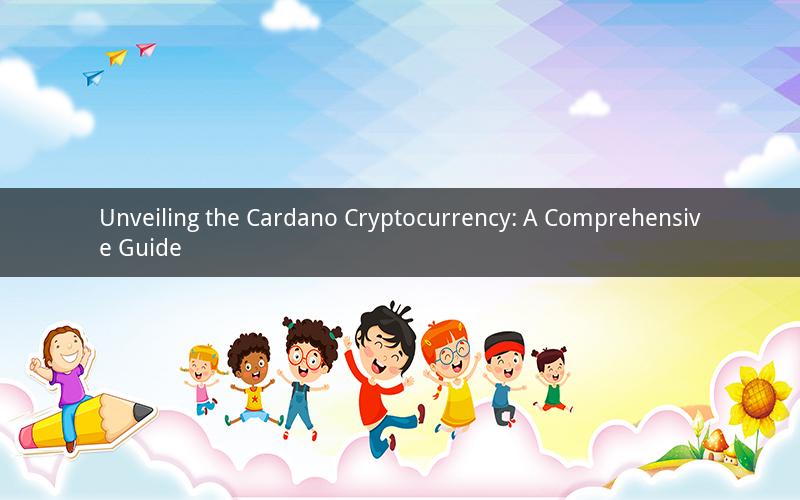
Cardano cryptocurrency, often referred to as ADA, has gained significant attention in the crypto market. As a third-generation blockchain platform, Cardano aims to offer a more secure, sustainable, and transparent ecosystem for digital transactions. In this article, we will delve into what Cardano is, its unique features, and its potential future in the crypto world.
What is Cardano Cryptocurrency?
Cardano is a decentralized blockchain platform that was founded by Charles Hoskinson, who also co-founded Ethereum. It was launched in 2017 and is designed to be a more scalable, secure, and sustainable alternative to Bitcoin and Ethereum. Cardano operates on a proof-of-stake algorithm called Ouroboros, which is considered to be more energy-efficient than the proof-of-work algorithm used by Bitcoin and Ethereum.
Cardano's mission is to provide a platform that can support smart contracts and decentralized applications (DApps) while addressing the limitations of existing blockchain platforms. By focusing on sustainability, Cardano aims to become the backbone of a new generation of decentralized applications.
Unique Features of Cardano
1. Proof-of-Stake Algorithm: Cardano utilizes the Ouroboros algorithm, which is a proof-of-stake protocol that is designed to be more energy-efficient than proof-of-work. This allows Cardano to achieve better scalability and sustainability while maintaining security.
2. Smart Contracts: Cardano has developed its own scripting language called Plutus, which is designed to enable the creation of smart contracts. These smart contracts can be used to create decentralized applications that can perform a wide range of functions, from simple transactions to complex decentralized finance (DeFi) applications.
3. Layered Architecture: Cardano has a layered architecture that separates the settlement layer (where ADA tokens are transferred) from the computation layer (where smart contracts are executed). This allows for better scalability and security, as each layer can be optimized independently.
4. Governance: Cardano has a unique governance model that allows stakeholders to participate in the decision-making process. This model is designed to ensure that the platform remains decentralized and that decisions are made in the best interest of the entire community.
5. Interoperability: Cardano aims to be interoperable with other blockchain platforms, which means that ADA tokens can be used across different networks. This allows for better integration of digital assets and facilitates cross-chain transactions.
Cardano's Potential Future
As a third-generation blockchain platform, Cardano has the potential to become a significant player in the crypto market. Here are some of the potential future developments for Cardano:
1. Scalability: Cardano's layered architecture and proof-of-stake algorithm are designed to address scalability issues. As the platform continues to grow, it may become a more viable alternative to Bitcoin and Ethereum for high-volume transactions.
2. Smart Contracts: Cardano's Plutus scripting language is still in development, but it has the potential to enable the creation of sophisticated smart contracts. As this language becomes more widely used, Cardano could become a hub for innovative DApps.
3. Interoperability: Cardano's interoperability with other blockchain platforms could lead to a more integrated crypto ecosystem. This could result in increased adoption of ADA tokens and a wider range of use cases.
4. Governance: As Cardano's governance model continues to evolve, it may become a model for other blockchain platforms. This could lead to a more transparent and decentralized crypto market.
5. Sustainability: Cardano's focus on sustainability is a key differentiator in the crypto market. As environmental concerns continue to grow, Cardano may become a more attractive option for investors and users who prioritize sustainability.
Frequently Asked Questions
Q1: What is the difference between Cardano and Bitcoin?
A1: Cardano is a third-generation blockchain platform that aims to offer a more scalable, secure, and sustainable ecosystem for digital transactions, while Bitcoin is a decentralized digital currency that operates on a proof-of-work algorithm.
Q2: Can Cardano replace Bitcoin?
A2: While Cardano has the potential to become a significant player in the crypto market, it is unlikely to replace Bitcoin. Bitcoin remains the most well-known and widely accepted cryptocurrency, and it has a strong network effect that makes it difficult for other cryptocurrencies to surpass.
Q3: How does Cardano's proof-of-stake algorithm work?
A3: Cardano's proof-of-stake algorithm, Ouroboros, is designed to be more energy-efficient than proof-of-work. It works by randomly selecting validators to create new blocks, which reduces the amount of energy required to maintain the network.
Q4: What is the purpose of Cardano's Plutus scripting language?
A4: Cardano's Plutus scripting language is designed to enable the creation of smart contracts. It allows developers to write code that can execute complex transactions and automate various processes within decentralized applications.
Q5: How does Cardano's governance model work?
A5: Cardano's governance model allows stakeholders to participate in the decision-making process. It is designed to ensure that the platform remains decentralized and that decisions are made in the best interest of the entire community. Stakeholders can vote on proposals and amendments to the protocol.